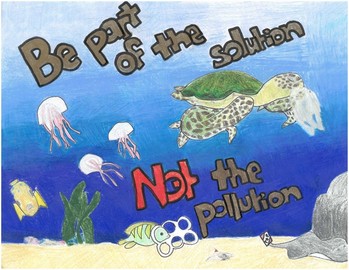 Artwork by Samantha C. (Grade 6, Michigan), winner of the Annual NOAA Marine Debris Program Art Contest.
Thank you to everyone who provided feedback on our newsletter survey! We are continuing to work on a few different updates to address your interests, including our recent “Micro-Newsletter” with more timely content. We are also hoping to introduce some stories of educators and how they are implementing practical marine debris solutions in their learning environments. Stay tuned for more!
Spring Is Just Around the Corner!
If you’re looking for a great, quick upcycling activity to try this season, check out our Plastic Bottle Bird Feeder at the end of this newsletter!
Here's what you can find in this newsletter:
For Elementary School:
For Middle School:
For High School and Older:
And for our subscribers in California, Florida, and the Pacific Islands, check out our Marine Debris Projects Near You section below to learn more about some of the exciting work happening in your region to prevent marine debris!
Enthusiastically,
Alexandria Gillen,
NOAA Marine Debris Program Education Specialist
 Dive into this student-created series of videos in Spanish to learn about hurricanes and marine debris (Credit: Club Marina).
Club Marina is a group of female students interested in environmental science and conservation at Puerto Rico’s Escuela Especializada en Ciencias, Matemática y Tecnología (CIMATEC). In 2020-2021, they created a series of videos on hurricanes and marine debris in Spanish, with the support of the NOAA Marine Debris Program and the National Marine Sanctuary Foundation. The goal of this group of passionate changemakers is to educate and raise awareness about the dangers of marine debris, thereby helping the environment and the community, and empowering other girls. We invite you to follow Club Marina on its YouTube page where you will learn more about the subject.
Learn more
Best for: Middle School, High School and Older, Informal Audiences
Applicable Region(s): Caribbean
 Join the NOAA Marine Debris Program and the National Science Teaching Association this spring to learn about the science of marine debris (Credit: NOAA).
Mark your calendars! On April 20, the National Science Teaching Association (NSTA) will host the NOAA Marine Debris Program for an engaging informative webinar all about the science of marine debris and how to turn that science into solutions. The program is free, but participants must register. To register you must have an NSTA website account. A free account (GUEST USER) can be created here.
Learn more
Best for: High School and Older
Applicable Region(s): Anywhere
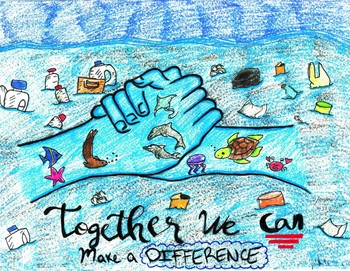 Artwork by Mia C. (Grade 8, Texas), winner of the Annual NOAA Marine Debris Program Art Contest.
The NOAA National Marine Protected Area Center and Open Communications for the Ocean will host a webinar on March 15 to introduce a new "youth ocean action toolkit" focused on the ocean literacy principles and marine protected areas (MPAs). This toolkit – written by youth for youth – provides community examples of how youth can take action to conserve their ocean; demonstrates the benefit of MPAs for ocean conservation; includes links to resources and multimedia content; and features a strong social media component. The toolkit will be available this summer in English and Spanish. This webinar featuring some of the toolkit’s youth authors will provide an overview of the content and techniques to engage and empower young people around the world.
Learn more
Best for: Middle School, High School and Older
Applicable Region(s): Anywhere
 NOAA Planet Stewards provides all educators working with elementary through college-aged students access to opportunities and resources enabling them to build up scientifically literate individuals and communities, and preparing them to respond to environmental challenges (Credit: NOAA).
Are you interested in taking action to address pressing environmental issues?
Through federal funding opportunities of up to $5,000, NOAA Planet Stewards supports formal and informal educators in carrying out hands-on stewardship projects with elementary through college age students, as well as the general public. Stewardship projects must make a substantive, and quantitatively measurable impact on an environmental issue related to the educator’s community. Projects should focus on the conservation, restoration, and/or protection of human communities and/or natural resources from environmental issues in one of the following four focus areas:
- Marine debris
- Habitat conservation and restoration
- Carbon footprint reduction
- Carbon sequestration
Project proposals are due June 4.
Learn more
Best for: Elementary School, Middle School, High School and Older
Applicable Region(s): All U.S. States and Territories
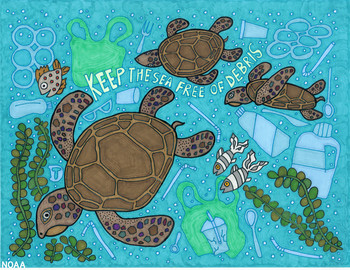 This artwork titled, "Keep the Sea Free of Debris," by Dagny T., grade 2, was one of the winners of the 2021 Annual Marine Endangered Species Art Contest hosted by NOAA Fisheries. (Dagny T., 2021 Marine Endangered Species Art Contest).
Celebrate Endangered Species Day (May 19) by having your classroom participate in the 2023 Marine Endangered Species Art Contest! Entries are due April 24.
Endangered and threatened species need our help. Students’ artwork will showcase their knowledge and commitment to protecting these animals. While the contest is hosted by the Greater Atlantic Region Fisheries Office located in New England and the mid-Atlantic United States, participants from anywhere in the world are invited to submit entries!
Artwork should highlight one or more marine endangered or threatened species from the New England/Mid-Atlantic region of the United States. Get the details on entry requirements, entry submissions, prizes, and more on the contest web page.
Learn more
Best for: Elementary School, Middle School, High School
Applicable Region(s): Anywhere
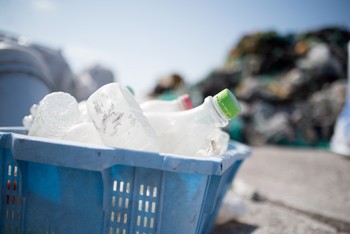 Practice engineering and design by transforming bottles like these into a model sailboat (Credit: NOAA).
The 4th Annual Recycle Regatta is ON! Students in grades K-12 are invited to compete in this free competition and learning event organized by Educational Passages, New England Science and Sailing, and the North American Marine Environment Protection Association. First, build a model sailboat out of recycled and repurposed materials. Then, race your boat to victory while learning all about engineering, mathematics, sailing, buoyancy, and stewardship. Classrooms, boating centers, families, and all community organizations are encouraged to take on the challenge.
The 2023 Recycle Regatta will encourage unique, experiential learning opportunities for students in grades K-12. Entries are due March 31.
Learn more
Best for: Elementary School, Middle School, High School, Informal Audiences
Applicable Regions: Anywhere
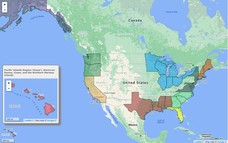
Check out some marine debris projects around the country.
|
After a highly competitive review process, the NOAA Marine Debris Program announced 8 recipients of the 2022 Marine Debris Prevention awards last year. The projects awarded under this nationwide competitive funding opportunity continue the NOAA Marine Debris Program’s commitment to develop impactful, community-driven, and cost-effective projects that benefit coastal habitats, waterways, wildlife, and surrounding communities. Learn more about the recipients and projects at the MDP website.
A number of these projects also engage students in and out of the classroom:
 If only this albatross had an awesome upcycled bird feeder! (Credit: NOAA).
A flock of blue jays frequently visit the tree outside my home office window. Their curious chirps inspired this activity, which takes old beverage bottles and turns them into a hanging bird feeder.
This One's for the Birds
This activity is pretty simple, so there are a lot of great opportunities to inspire sense-making and help students design their own bird feeders. Some possible engineering design questions could include:
- What kind of bottle should we use? Why?
- How can we help the birds get to the food in this feeder?
- What kind of bird seed should we use? Why?
- How and where should we hang our bird feeder?
Some of the answers to those questions might change your procedure a little bit. You can also try a few different approaches and see if they attract different birds!
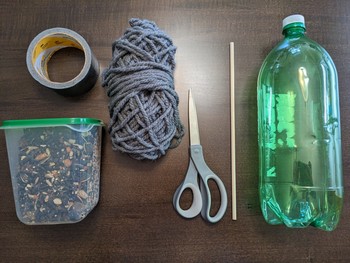 Supplies:
- Scissors* (child-safe scissors won't be strong enough to cut the bottles, so the bottle cutting should be completed by adults or with adult supervision)
- Plastic beverage bottle (clean and dry), with a cap
- Yarn or twine
- Duct tape
- A stick or dowel (this should be a couple inches wider than your bottle)
- Birdseed
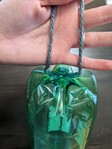
1. Carefully cut two holes in the bottom of your bottle. String your yarn or twine between the two holes, with plenty left over to tie a loop. This is how you will hang your bird feeder! (Safety Tip: The bottom of some plastic bottles is very thick! Cut carefully where the plastic is thinnest.)
|
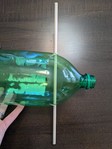
2. Carefully cut two holes in the sides of your bottle, a couple of inches down from the cap. Stick your dowel or other stick through the holes, with a bit hanging on either side. This will be a perch for the birds visiting your feeder!
|
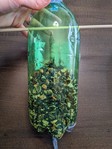
3. Carefully cut two more holes in the sides of your bottle, a couple of inches above the perch. Try to keep the holes fairly small, or else your seed will spill out. Fill up your bottle at least halfway with bird seed and secure the top.
|

4. Turn your bottle over and hang it in your desired spot. All that's left is to wait for the birds to pop in for a snack!
|
 While I was not able to get a photo of the rowdy blue jays, the other birds in the neighborhood seem to enjoy the feeder! (Credit: NOAA).
Looks like they like it!
Looking for a craft from a previous newsletter? Check out our NOAA Marine Debris Program Newsletter Archive page to revisit all of our past activities.
Interested in more ways to help prevent marine debris at home, at school, or at the store? Dive into all kinds of ideas on our How to Help page.
Have any feedback on our content?
Please complete this survey on the NOAA Marine Debris Program Education Newsletter if you have any questions, ideas, or hopes for our marine debris materials.
Contact us at marinedebris.web@noaa.gov
Subscribe to the NOAA Marine Debris Program Education Newsletter
Subscribe to the NOAA Marine Debris Program Monthly Newsletter
Subscribe to the Marine Debris Blog
|